Clouded Apollo
The clouded Apollo (Parnassius mnemosyne) is a butterfly species of the family of swallowtail butterflies (Papilionidae) found in the Palearctic realm.
| Clouded Apollo | |
|---|---|
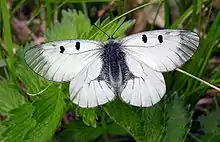 | |
| dorsal side | |
_female.jpg.webp) | |
| female ventral side, Estonia | |
| Scientific classification | |
| Kingdom: | Animalia |
| Phylum: | Arthropoda |
| Class: | Insecta |
| Order: | Lepidoptera |
| Family: | Papilionidae |
| Genus: | Parnassius |
| Species: | P. mnemosyne |
| Binomial name | |
| Parnassius mnemosyne | |
Clouded Apollos inhabit meadows and woodland clearings with plenty of flowering plants, both in the lowlands and in the mountains. It is not usually found at altitudes above 1500 m except in the Central Asian mountains where it is also known from higher altitudes.
Distribution
Its range of distribution extends from the Pyrenees, across the Central Massif, the Alps, and the Carpathians as far as central Asia. It inhabits all European countries including Norway, where it appears rarely and only in certain places. A subspecies lived in Denmark, but is now extinct. A great number of geographical races and individual forms are distinguished in this extensive region. The most striking specimens include the dark race from the eastern Bavarian Alps (subspecies hartmanni); form melania has the most pronounced dark colouring.
The paper of Dr. I.N. Bolotov and colleagues (2013) summarizes data on the northern localities of Parnassius mnemosyne, which are mostly situated in the Russian Federation and gives a thorough description of the species' northern range location.[1] It is shown that the northernmost populations in the exist within the karst landscapes in the north of White Sea-Kuloi Plateau (between 65°35' and 66°03' N) in the downstream of the Soyana and Kuloi rivers and in the north of Timan Highland (66°10' N) along the shore of Kosminskoe Lake (the Pechora River basin). Northern limits of the clouded Apollo's range appear to be strongly determined by the distribution of its larval host plants (primarily Corydalis solida and the role of climate and relief seem to be of minor importance. Many Russian populations inhabit the state nature reserve territories: Kizgi Scerries Reserve (Karelia Republic), Pinega and Soyansky reserves (Arkhangelsk Oblast), Pechoro-Ilychsky and Belaja Kedva reserves (Komi Republic).
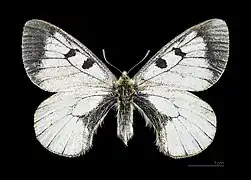 Male
Male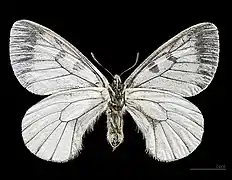 Male bottom
Male bottom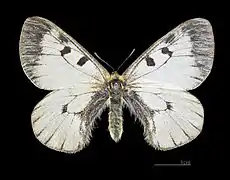 Female
Female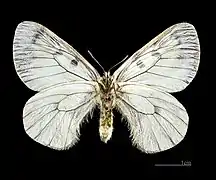 Female bottom
Female bottom
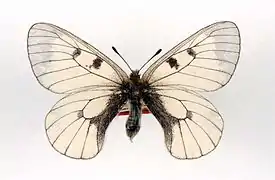 P. m. adamellicus
P. m. adamellicus Dark female from the Alps, P. m. hartmanni
Dark female from the Alps, P. m. hartmanni.jpg.webp) Caterpillar
Caterpillar
Habits
The clouded Apollo is locally common in some places in central Europe. The female lays whitish eggs with a granular surface. The caterpillar feeds only on sunny days, otherwise it is hidden under leaves or stones. The blunt-ended chrysalis lies on the ground in a light spun covering. The caterpillars feed exclusively on Corydalis species.[2] To prevent the continuing disappearance of this butterfly from many places in central Europe, it is now protected in some regions. They inhabit small patches and individuals move from patch to patch and conservation of a network of patches is required to maintain the gene pool.[3]
Etymology
The species was named in the classical tradition for Mnemosyne the mother of the nine Muses
Subspecies
partial list
- Parnassius mnemosyne adamellicus
- Parnassius mnemosyne balcanica [Bryk & Eisner, 1930]
- Parnassius mnemosyne bucharanus [Bryk, 1912]
- Parnassius mnemosyne caucasia [Verity, [1911] ]
- Parnassius mnemosyne craspedontis [Fruhstorfer, 1909]
- Parnassius mnemosyne falsus [Pagenstecher, 1911]
- Parnassius mnemosyne giganteus [Staudinger, 1886]
- Parnassius mnemosyne leonhardiana [Fruhstorfer, 1917]
- Parnassius mnemosyne nivalis [Grose-Smith, 1908]
- Parnassius mnemosyne nubilosus [Christoph, 1873]
- Parnassius mnemosyne ochraceus [Austaut, 1891]
- Parnassius mnemosyne orientalis [Verity, 1911]
- Parnassius mnemosyne parnassia [Bryk, 1932]
- Parnassius mnemosyne problematicus [Bryk, 1912]
- Parnassius mnemosyne talboti [Bryk, 1932]
- Parnassius mnemosyne ucrainicus [Bryk & Eisner, 1932]
- Parnassius mnemosyne ugrjumovi [Bryk, 1914]
- Parnassius mnemosyne uralka [Bryk, 1921]
- Parnassius mnemosyne valentinae [Sheljuzhko, 1943]
- Parnassius mnemosyne weidingeri [Bryk & Eisner, 1932]
For a list of subspecies types in the British Museum (Natural History), see Ackery, P. R. (1973) "A list of the type-specimens of Parnassius (Lepidoptera: Papilionidae) in the British Museum (Natural History)". Bulletin of the British Museum (Natural History) Entomology 29 (1) (9.XI.1973): 1—35, 1 pl. online here
References
- Bolotov I.N., Gofarov M.Y., Rykov A.M., Frolov A.A., Kogut Y.I. 2013. Northern boundary of the range of the Clouded Apollo butterfly Parnassius mnemosyne (L.) (Papilionidae): climate influence or degradation of larval host plants? – Nota lepid. 36 (1): 19–33.
- Hansen Lars Ove and Aarvik Leif, Trondheim. 2004 Clouded Apollo - Parnassius mnemosyne (Linnaeus, 1758), data sheet Archived 2007-05-29 at the Wayback Machine in Lepidoptera of Norway Archived 2007-07-29 at the Wayback Machine
- VÄLIMÄKI Panu, ITÄMIES, Juhani. 2003 Migration of the clouded Apollo butterfly Parnassius mnemosyne in a network of suitable habitats: effects of patch characteristics. Ecography 26(5):679-691
External links
- Funet
- P. mnemosyne images at Consortium for the Barcode of Life
- Butterfly Conservation Armenia: Parnassius mnemosyne
| Wikispecies has information related to Parnassius (Driopa) mnemosyne. |
| Wikimedia Commons has media related to Parnassius mnemosyne. |